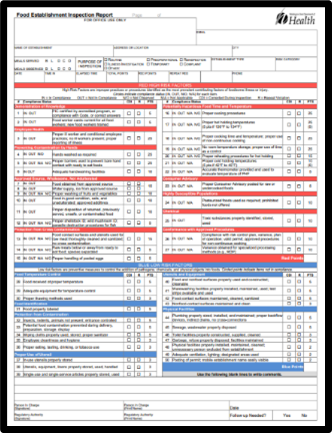Food Establishment Inspection Report
Welcome to the new Inspection Search program for all Food Establishments in Mason County. Simply select the type of Establishment and then enter the Food Establishment Name in the Search box. A complete list of inspections for that food establishment will be available to view in PDF format. As we continue to use our new program to complete inspections, more will become available. We are excited to provide full inspection reports to the Mason County Communities. Please be patient as this is a new program, and we may run into a few technical difficulties along the way.
If you find any complications with the new search engine, please email foodsafety@masoncountywa.gov
 What is a Food Establishment Inspection Report:
What is a Food Establishment Inspection Report:
A Food Establishment Inspection report is a snapshot of the food safety practices, and management system observed on that specific day and time. This is one course of action by the local health jurisdiction to monitor and evaluate that all establishments are following Washington State Retail Food code and doing their part in preventing food borne Illness. There are multiple types of inspections: Pre-Operational, Routine, Re-Inspection, Complaint, Illness Investigation, and Temporary.
Routine inspections are the most common and consist of a complete inspection of the Establishment. We evaluate all Critical RED High Risk Factors that contribute to Foodborne Illness and Low BLUE Risk Factors that are preventive measures to control cross-contamination of food.
Non-critical Violations (blue), not directly related to the cause of foodborne illness, but if uncorrected, could hinder the operation of the restaurant. The likelihood of foodborne illness in these cases is very low. However, if non-critical violations are not corrected, they could lead to critical violations. Examples of non-critical violations include a lack of facility cleanliness and maintenance, or improper cleaning of equipment and ventilation.
Critical Violations (red), of the Food Code, if left uncorrected, are more likely to directly contribute to food contamination or foodborne illness. Examples of critical violations include poor temperature control of food from improper cooking, cooling, cold-holding, or reheating, OR poor food worker hygiene to include ill workers or improper or no hand washing. These problems can create environments that cause bacteria to grow and thrive, which can put the customer at risk for foodborne illness.
During the inspection, notes will be made in reference to violations that are OUT of compliance. The witnessed or tested observation of what exactly was found will be documented, along with the violation that is Out of compliance and the corrective action required to comply. Most red violations are required to be corrected immediately during the inspection (CDI). Blue violations may be allowed time to be corrected as they are deemed not immediate public health risk violations.
Food Establishment Inspection Frequencies and Information:
Food establishments are routinely inspected every 6 months, depending on the type of establishment and complexity of their menu. Example: a Coffee Stand that does not cook or re-heat food may be inspected less if no violations have been noted during past inspections. A Mobile Unit or Restaurant is inspected every 6 months. Reinspection’s are required if a Food Establishment Fails the routine inspection or is required to close due to an inspection failure. All new Food Establishments require a pre-operational inspection prior to opening. Complaint and Illness inspections are on an as needed bases, when complaints are received by public, or a Foodborne Illness is reported to Public Health.
Food Safety Inspection Monthly Summaries
Below you will find monthly summaries of the food inspections performed. In 2025 the summary pages will consist of a list of completed inspections, with the RED & Blue Violation scores noted. It also lists the Establishments Status following the inspection.

